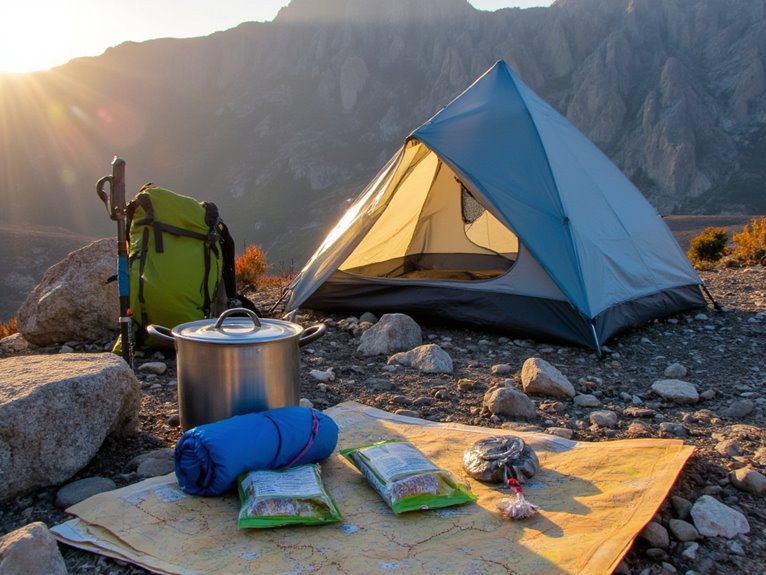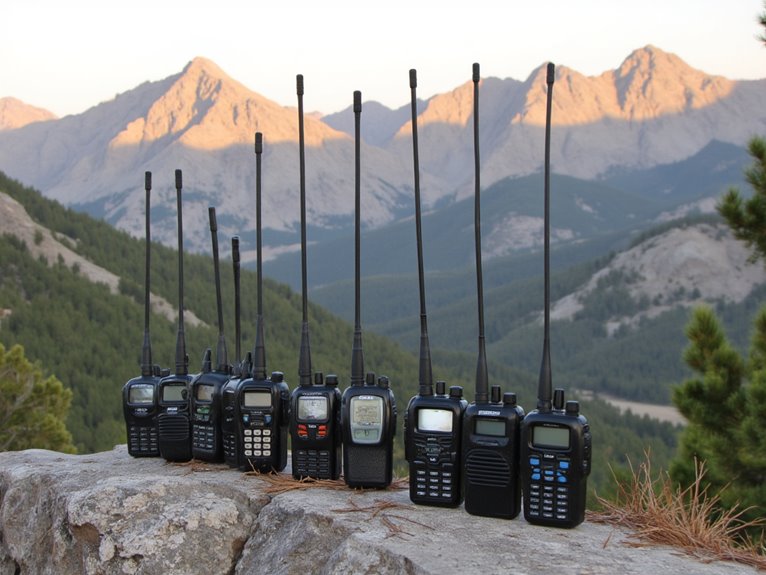What Counts as Ultralight Backpacking Gear?
Ultralight backpacking gear meets strict weight thresholds: your total base weight excluding food, water, and fuel must stay under 10 pounds, with super ultralight targeting under 5 pounds. You’ll need backpacks weighing under 2.5 pounds, shelters like tarps (8-12 oz) or ultralight tents (under 2 pounds), sleep systems combining quilts and pads under 2 pounds total, plus multi-use items that serve dual purposes. Advanced materials like Dyneema and carbon fiber enable these dramatic weight reductions while maintaining durability and performance standards for serious trail applications.
We are supported by our audience. When you purchase through links on our site, we may earn an affiliate commission, at no extra cost for you. Learn more. Last update on 9th December 2025 / Images from Amazon Product Advertising API.
Notable Insights
- Ultralight backpacking requires a total base weight under 10 pounds, excluding food, water, and fuel consumables.
- Backpacks must weigh no more than 2.5 pounds with a weight-to-volume ratio of 0.7 ounces per liter or less.
- Shelters include ultralight tents under 2 pounds, basic tarps at 8-12 ounces, or bivvy sacks weighing 12-20 ounces.
- Sleep systems feature down sleeping bags or quilts under 2 pounds and ultralight pads weighing 13-20 ounces.
- Multi-use gear strategies maximize function while minimizing weight, like trekking poles doubling as tent poles.
Weight Thresholds and Base Weight Standards for Ultralight Gear
Weight classifications in ultralight backpacking aren’t governed by any official standards, but the community has established clear thresholds based on decades of collective experience.
You’ll find ultralight defined as a base weight under 10 pounds, while Super Ultralight (SUL) requires sub-5-pound loads. Lightweight backpacking falls between 10-20 pounds, and traditional packs exceed 20 pounds.
These weight comparisons provide essential benchmarks for your gear evaluation process. Base weight excludes consumables like food, water, and fuel—only core equipment counts.
Your body size affects these standards since larger hikers need heavier gear for safety and comfort. The 10-pound threshold remains most widely accepted across forums and experienced hikers, though some use 11-pound or 9.9-pound variations depending on regional preferences.
Essential Gear Categories That Define Ultralight Backpacking
While achieving ultralight status requires cutting weight across your entire gear selection, five core categories form the foundation of every backpacker’s load: shelter, sleep system, cooking equipment, clothing, and navigation tools.
Your shelter system includes tents, tarps, bivies, or hammocks with necessary accessories like ground cloths and insect protection.
Sleep systems encompass your sleeping bag or quilt, pad, and pillow.
Cooking gear covers stoves, fuel, lighters, cookware, and utensils.
Clothing focuses on lightweight hiking shoes, synthetic or wool shirts, shorts, and pants.
Navigation tools include maps, compasses, phones, GPS devices, and chargers.
For ultralight backpacking, sleeping pads should prioritize minimal weight while ultralight options maintain essential comfort and insulation properties for weight-conscious hikers.
Effective weight management demands scrutinizing each category systematically.
You’ll need to balance functionality with weight savings, often choosing multi-use items that serve multiple purposes across categories.
Material Technologies That Make Gear Ultralight
Revolutionary material science has transformed ultralight backpacking over the past decade, enabling gear manufacturers to slash weight without sacrificing durability or performance. You’ll find today’s cutting-edge gear utilizes material innovation that seemed impossible just years ago.
| Material Type | Primary Applications |
|---|---|
| Carbon fiber poles | Trekking poles, tent frames |
| Dyneema fabric | Tent bodies, stuff sacks |
| Ultra 100X material | Backpack construction |
Advanced fabrics like ripstop nylon incorporate specialized weave patterns that increase strength while reducing density. Cuben fiber offers exceptional waterproof properties at minimal weight, though higher costs limit widespread adoption. Manufacturing techniques including 3D printing enable precise material distribution. Aluminum alloy frames provide structural support without bulk. These innovations deliver gear that’s 40-60% lighter than traditional alternatives.
Weight Specifications for Ultralight Backpacks and Carrying Systems

When you’re selecting ultralight backpacks and carrying systems, you’ll need to understand specific weight thresholds that define true ultralight performance.
Your pack itself should weigh no more than 2.5 pounds, while maintaining a weight-to-volume ratio of 0.7 ounces per liter or less.
These specifications directly impact your overall base weight target of 4.5 kg (9.9 pounds) or less for the entire gear system.
Base Weight Standards
Base weight serves as the fundamental metric for categorizing backpacking approaches and determining gear efficiency.
You’ll find ultralight backpacking defined by a base weight under 10 pounds, excluding consumables like food, water, and fuel. This Ultralight Philosophy emphasizes carrying only essential gear at minimum weights.
Super ultralight backpackers push boundaries further with base weights under 5 pounds. This requires specialized equipment and eliminates most conveniences.
Weight Comparison reveals significant differences: lightweight backpackers carry 10-20 pounds, traditional backpackers manage 15-30 pounds, while conventional approaches often exceed 35 pounds total.
Your base weight shouldn’t exceed 20% of your body weight for ideal efficiency.
Achieving ultralight standards demands careful gear selection and often higher costs, but delivers substantial benefits in reduced physical strain and enhanced hiking performance.
Pack Weight Limits
Since ultralight backpack specifications determine your entire gear strategy, understanding weight limits becomes essential for safe and efficient trail performance.
True ultralight backpacks weigh less than 1 kg (2.2 lb), with top models achieving sub-1 kg specifications. These packs typically handle maximum loads of 27-30 kg (60 lbs), though ideal performance occurs below 15 kg (33 lb) total pack weight.
Design compromises affect hiking efficiency considerably. Minimal padding and simplified frame systems reduce weight but limit comfort under heavy loads. Most ultralight packs feature 40-60 liter capacity with removable components like hipbelts and load lifters.
External attachment points compensate for reduced internal volume.
Your safety depends on respecting manufacturer load ratings. Ultralight materials like Dyneema provide strength-to-weight ratios that support recommended limits when properly distributed across the carrying system.
Shelter Options That Meet Ultralight Requirements

You’ll need to make strategic choices about shelter systems to achieve true ultralight status while maintaining protection from the elements.
Your options range from basic tarps weighing just 8-12 oz that require separate groundsheets and bug protection, to complete ultralight tent systems under 2 pounds that include integrated floors and mesh panels.
Minimalist bivvy sacks offer the lightest single-person solution at 12-20 oz, though they sacrifice space and comfort for maximum weight savings.
Tarps Over Traditional Tents
When you’re serious about cutting pack weight, tarps represent one of the most dramatic gear swaps you can make. The tarp advantages are immediately apparent in weight savings—you’ll drop from 32+ ounces for traditional tents to just 8.4–14 ounces for quality ultralight models. That’s more than half your shelter weight eliminated.
Silnylon and DCF tarps deliver exceptional weather protection through waterproof coatings and factory-taped seams. You’ll get superior ventilation that reduces condensation, plus multiple setup configurations from A-frame to lean-to pitches.
Sizes like 7’x9′ handle solo trips, while 8’x10′ offers extra coverage.
The trade-offs include reduced bug protection and privacy. Entry-level silnylon models start at $110, while premium DCF options reach $400. Your pack space and hiking comfort improve dramatically.
Ultralight Tent Specifications
Ultralight tents offer a middle ground between tarps and traditional shelters, maintaining the weight advantages while restoring bug protection and privacy. These tent designs meet the two-pound threshold through efficient materials and construction methods.
| Model | Weight | Price | Key Feature |
|---|---|---|---|
| X-Mid 2 | 31 oz | $369 | Trekking pole structure |
| Zpacks Pivot Duo | 18.6 oz | $849 | DCF construction |
| Gossamer Gear The Two | 1.5 lbs | $320 | Value option |
| Hornet OSMO | 2 lb 4 oz | $450 | 20.6 sq ft floor |
Modern ultralight features include silpoly fabrics, DCF materials, and narrow seams that reduce weight without sacrificing durability. Trekking pole structures eliminate tent poles entirely. Vertical sidewalls maximize interior volume while maintaining stormworthiness through efficient geometry.
Minimalist Bivvy Solutions
Three shelter options exist at the extreme lightweight end of the spectrum: tarps, ultralight tents, and bivvy sacks.
Bivvy sacks weigh 4.5 to 7.5 ounces and pack smaller than tents. They’re made from breathable, waterproof fabrics like Pertex Quantum Pro with high seam placement.
Bivy advantages include significant weight savings and minimal pack volume:
- Temperature boost: Add 4-8 degrees of warmth to your sleep system
- Protection: Shield against drafts and insects when paired with quilts
- Stealth camping: Enable cowboy camping and minimalist shelter setups
- Packability: Compress to under 12 fluid ounces in stuffsack size
- Pairing flexibility: Combine with tarps for complete weather protection
Bivy limitations involve space restrictions and privacy concerns.
You’ll lack gear storage space inside and experience potential claustrophobia in tight models.
Sleep Systems and Insulation for Weight-Conscious Backpackers
Although comfort might seem like a luxury you can’t afford when every ounce counts, modern sleep systems prove that weight-conscious backpackers don’t have to sacrifice quality rest.
Smart gear selection allows ultralight enthusiasts to enjoy restorative sleep without adding unnecessary bulk to their pack.
You’ll find sleeping bags and quilts offering different comfort features based on your needs. Down insulation provides superior warmth-to-weight ratios, while synthetic fills maintain thermal insulation when wet.
Packability considerations matter considerably—quilts often beat traditional sleeping bags here. Their quilt advantages include reduced weight and better temperature regulation.
Integrated systems combine pads, bags, and pillows efficiently. Pad construction features like air sprung cells and ASTM-tested R-values guarantee ground insulation.
Lightweight materials such as nylon and pongee enhance sleep comfort while minimizing pack weight. These systems optimize rest without compromising your ultralight goals.
For true ultralight performance, focus on sleeping bags that weigh under 2 pounds and feature compression sacks that can reduce packed size to water bottle dimensions.
Multi-Use Items and Gear Modifications for Maximum Weight Reduction
Every experienced backpacker knows that carrying multiple single-purpose items creates unnecessary weight, but mastering multi-use gear strategies can slash your base weight by 10-20% without compromising safety or comfort.
Smart gear combinations start with identifying overlapping functions. Your puffy jacket doubles as a pillow. Trekking poles eliminate separate tent poles. Cooking pots serve triple duty for boiling, eating, and drinking.
Essential multi-use modifications deliver maximum weight savings:
- Cut toothbrush handles and trim gear tags
- Remove unnecessary pack straps and zippers
- Replace heavy tent guylines with lightweight cord
- Use sit pads as emergency splints
- Transform tarps into ground covers and rain shelters
Test these combinations at home before hitting the trail.
Focus on items with clearly documented multiple uses while avoiding redundant functions that compromise safety.
When selecting sleep gear, prioritize ultralight sleeping pads that weigh just 13-20 ounces and include built-in foot pumps to eliminate carrying separate inflation equipment.


